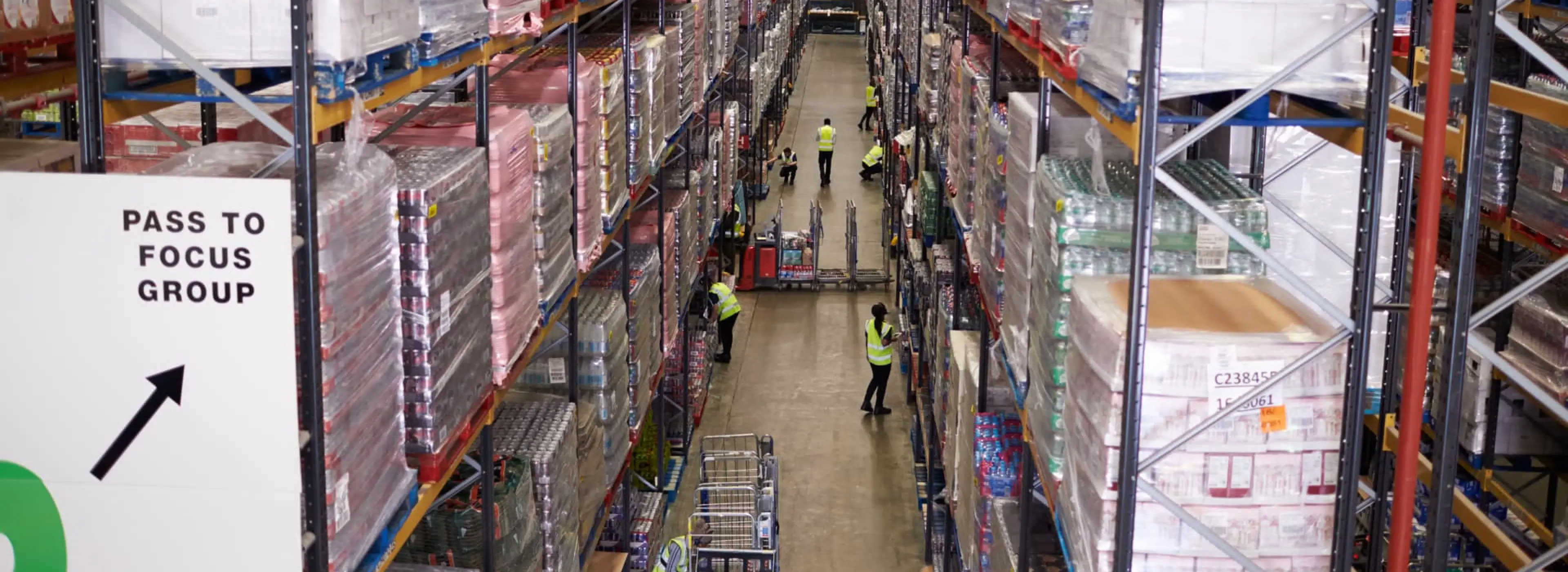For more content about warehouse efficiency or the latest technology trends, you can follow us on LinkedIn, YouTube, X, or Facebook. If you have other inquiries or suggestions, don’t hesitate to contact us here. We’ll be happy to hear from you.
Demand forecasting plays a pivotal role in driving success. Understanding and accurately predicting customer demand can be the difference between stockouts and overstock, lost sales, or maximizing profitability. That’s why mastering the art of demand forecasting is crucial for any business or warehouse looking to boost its bottom line.
Click Here: Effectively Manage Your Inventory With This Advanced and Affordable WMS
This comprehensive guide will take you through the ins and outs of demand forecasting, equipping you with the knowledge and strategies to make informed decisions. We’ll explore the different methods and techniques, from statistical models to predictive analytics, and delve into the challenges and best practices associated with demand forecasting. Ready? Read more below.
What is Demand Forecasting?
Demand forecasting is the process of estimating future customer demand for a product or service. It involves analyzing historical sales data, market trends, customer behavior, and other relevant factors to predict future demand with a certain level of accuracy. By understanding future demand, businesses can make informed decisions about production, inventory management, marketing strategies, and resource allocation.
Demand forecasting is not limited to a specific industry or sector. It applies to businesses of all sizes and across various sectors, including retail, e-commerce, manufacturing, and logistics. Demand forecasting accuracy can vary depending on the available data, forecasting techniques used, and external factors that may impact demand.

What are the Importance and Benefits of Demand Forecasting?
Demand forecasting plays a pivotal role in the success and sustainability of businesses across various industries. Its importance lies in its ability to provide valuable insights and help companies to make informed decisions. Here are several vital reasons why demand forecasting is crucial for businesses:
- Inventory Management: Accurate demand forecasts enable businesses to maintain optimal inventory levels. Overstocking ties up capital and storage space, while understocking can lead to lost sales and dissatisfied customers. Demand forecasting helps strike the right balance, reducing carrying costs and preventing stockouts.
- Cost Reduction: Effective demand forecasting can lead to cost savings. By aligning production and procurement with anticipated demand, businesses can reduce excess capacity, minimize wastage, and streamline their supply chain operations.
- Customer Satisfaction: Meeting customer demand on time is essential for customer satisfaction. Accurate forecasts ensure that products or services are available when and where customers want them, enhancing their experience and loyalty.
- Production Planning: Manufacturers use demand forecasts to plan production schedules efficiently. This reduces the risk of overproduction or underproduction, leading to cost savings and better resource allocation.
- Resource Allocation: Demand forecasting guides resource allocation across the organization. It helps businesses allocate human resources, machinery, and raw materials effectively to meet future demand.
- Marketing and Promotion: Demand forecasts provide insights into when and where marketing efforts and promotions should be targeted. This allows businesses to optimize their marketing budgets and maximize the impact of their campaigns.
- Financial Planning: Accurate demand forecasts are essential for financial planning and budgeting. They help businesses project revenue, allocate resources, and make informed investment decisions.
- Risk Mitigation: Demand forecasting can help businesses identify potential risks and plan for contingencies in volatile markets or industries. It allows for proactive measures to mitigate the impact of market fluctuations or unexpected events.
- Strategic Decision-Making: Demand forecasts inform strategic decisions such as product development, market expansion, and capacity expansion. Businesses can align their long-term plans with anticipated market trends and customer preferences.
- Supply Chain Optimization: An efficient supply chain is crucial for cost control and meeting customer demands. Demand forecasts facilitate supply chain optimization by providing visibility into future requirements.
- Seasonal Planning: Many businesses experience seasonal fluctuations in demand. Demand forecasting helps them prepare for peak seasons by adjusting inventory, staffing, and production levels accordingly.
- Competitive Advantage: Businesses that can accurately forecast demand are better positioned to respond to market changes and customer preferences. This agility can give them a competitive advantage over competitors who struggle with demand volatility.
What are the Methods of Demand Forecasting?
There are several methods and techniques used for demand forecasting, each with its own strengths and limitations. The choice of forecasting method depends on factors such as the availability of data, the nature of the product or service, and the desired level of accuracy. Here are some of the most commonly used demand forecasting methods:
1. Qualitative Methods
Qualitative methods rely on expert judgment, market research, and surveys to predict future demand. These methods are useful when historical data is limited or when there are significant changes in market conditions. Qualitative methods include the following types:
- Market Research: Conducting surveys, focus groups, and interviews to gather information on customer preferences, expectations, and buying behavior.
- Expert Opinions: Seeking input from industry experts, sales representatives, and other knowledgeable individuals to make informed forecasts.
- Delphi Method: A structured approach that involves multiple rounds of surveys and feedback from a panel of experts to reach a consensus on future demand.
2. Time Series Analysis
Time series analysis is a statistical technique that uses historical sales data to forecast future demand. It assumes that future demand patterns will be similar to past patterns. Time series analysis methods include the following:
- Moving Averages: Calculating averages of past data points over a specific time period to identify trends and patterns.
- Exponential Smoothing: Assigning weights to recent data points to give more importance to recent observations when making forecasts.
- Decomposition: Breaking down time series data into its underlying components, such as trend, seasonality, and random variation.
- Box-Jenkins (ARIMA): A more advanced method for modeling and forecasting time series data, particularly when dealing with complex patterns.
3. Causal/Regression Analysis
Causal methods establish a cause-and-effect relationship between demand and other variables, such as price, promotions, or economic indicators. These methods are suitable when there is a clear relationship between the independent variable and demand. Causal methods include the following:
- Linear Regression: Analyzing the relationship between demand and one or more independent variables (e.g., price, advertising expenditure) to make predictions.
- Multiple Regression: Extending linear regression to consider multiple independent variables that can impact demand.
- Non-linear Regression: Accounting for non-linear relationships between variables when predicting demand.
4. Predictive Analytics
Predictive analytics combines advanced statistical techniques, machine learning algorithms, and big data analysis to forecast future demand. It leverages historical data, customer behavior patterns, and external factors to generate accurate demand forecasts. Predictive analytics methods include the following:
- Neural Networks: Using artificial neural networks to model and forecast demand, especially when dealing with complex, non-linear relationships.
- Random Forests: An ensemble learning method that combines multiple decision trees to make predictions based on historical data.
- Support Vector Machines: A machine learning technique that can be used for forecasting when there are clear boundaries between different demand patterns.
Each demand forecasting method has its advantages and limitations. Some methods may be more suitable for short-term forecasts, while others are better suited for long-term forecasts. It’s essential to choose the right method based on the specific requirements of your business and the available data. In the next section, we will explore the factors that influence demand forecasting accuracy.
Factors Influencing Demand Forecasting Accuracy
Several factors can impact the accuracy of demand forecasting. Understanding these factors is crucial to improve the reliability of your forecasts and make better business decisions. Here are some key factors that influence demand forecasting accuracy:
- Data Quality and Availability: The quality and availability of data have a significant impact on the accuracy of demand forecasting. Reliable and comprehensive data, including historical sales data, market trends, and customer behavior, are essential for accurate forecasts. Poor data quality or limited data can lead to inaccurate forecasts and unreliable insights.
- Seasonality and Trends: Seasonality refers to recurring patterns in demand that occur at regular intervals, such as holidays or seasonal events. Trends refer to long-term changes in demand that can be upward or downward. Seasonality and trends must be considered when forecasting demand to account for their impact on future sales.
- External Factors: External factors, such as economic conditions, competitor activities, government policies, and natural disasters, can significantly impact demand. These factors must be considered when forecasting demand as they can influence consumer behavior and market dynamics.
- Forecasting Horizon: The forecasting horizon refers to the time period for which the forecast is made. Short-term forecasts are typically more accurate because they are based on recent data and less influenced by external factors. Long-term forecasts are more challenging to predict accurately due to the uncertainties associated with future market conditions.
- Forecasting Techniques: The choice of forecasting technique can also influence the accuracy of demand forecasts. Different techniques have different strengths and limitations, and their suitability may vary depending on the nature of the product or service being forecasted.
By considering these factors and using appropriate forecasting techniques, businesses can improve the accuracy of their demand forecasts and make better decisions. The next section will explore the steps involved in creating an effective demand forecasting model.
Steps to Create an Effective Demand Forecasting Model
Creating an effective demand forecasting model involves a series of steps that ensure the accuracy and reliability of the forecasts. While the specific steps may vary depending on the chosen forecasting method and the complexity of the business, here is a general framework that can be followed:
- Define the Objective: Clearly define the objective of the demand forecasting model. Determine what you want to achieve with the forecasts and how they will be used in decision-making processes.
- Gather Data: Collect and organize relevant data, including historical sales data, market data, customer data, and any other information that can help in forecasting demand. Ensure the data is reliable, accurate, and comprehensive.
- Preprocess Data: Clean and preprocess the data to remove any outliers, inconsistencies, or missing values. Transform the data into a suitable format for analysis and ensure its quality and integrity.
- Choose Forecasting Technique: Select the most appropriate forecasting technique based on the data’s nature, the desired accuracy level, and the business’s specific requirements. Consider factors such as data patterns, seasonality, trends, and external factors.
- Build the Model: Develop the demand forecasting model using the chosen technique. Train the model using historical data and validate its performance using appropriate evaluation metrics.
- Validate and Refine: Validate the model’s accuracy by comparing the forecasted and actual values. Identify any discrepancies or errors and refine the model accordingly. Continuously monitor and update the model as new data becomes available.
- Evaluate and Interpret: Evaluate the performance of the demand forecasting model using suitable metrics, such as mean absolute error (MAE) or mean absolute percentage error (MAPE). Interpret the results and assess the model’s reliability and usefulness for decision-making.
By following these steps, businesses can create effective demand forecasting models that provide accurate and reliable forecasts. The next section will explore some of the tools and software available to get the benefits of demand forecasting.

Tools and Software for Demand Forecasting
Demand forecasting can be a complex and time-consuming process, especially when dealing with large volumes of data. Fortunately, there are several tools and software available that can simplify the process and improve the accuracy of forecasts. Here are some popular tools and software for demand forecasting:
- Excel: Excel is a versatile tool that can be used for basic demand forecasting tasks. It offers various functions and features for data analysis, trend analysis, and statistical modeling. Excel is suitable for small businesses or individuals who have limited data and forecasting requirements.
- Statistical Software: Statistical software, such as SPSS, SAS, or R, provides advanced data analysis capabilities and a wide range of statistical models for demand forecasting. These software packages are more suitable for businesses with complex data and advanced forecasting needs.
- Forecasting Software: Forecasting software, such as ForecastPro, Oracle Demand Planning, or SAP Integrated Business Planning, offers comprehensive demand forecasting functionalities. These software solutions often integrate with other business systems, such as ERP or a logistics CRM, and provide advanced analytical capabilities.
- Machine Learning Platforms: Machine learning platforms, such as TensorFlow, Scikit-learn, or Amazon Forecast, leverage machine learning algorithms and big data analysis to generate accurate demand forecasts. These platforms are suitable for businesses with large volumes of data and complex forecasting requirements.
The choice of tool or software depends on factors such as the complexity of the business, the volume of data, the desired level of accuracy, and the available budget. It’s essential to evaluate the features, functionalities, and compatibility of different tools before deciding.
Best Practices for Demand Forecasting
Demand forecasting is a complex process that requires careful planning, data analysis, and continuous improvement. By following best practices, businesses can improve the accuracy of their forecasts and make better decisions. Here are some best practices for demand forecasting:
- Use Multiple Forecasting Methods: Use a combination of qualitative and quantitative forecasting methods to improve the accuracy of forecasts. Each method has its strengths and limitations, and using multiple methods can provide a more comprehensive view of future demand.
- Continuously Monitor and Update: Demand forecasting is not a one-time process. Continuously monitor the accuracy of forecasts and update the models as new data becomes available. Regularly evaluate the performance of the models and refine them based on feedback and insights.
- Incorporate External Factors: Consider external factors, such as market trends, competitor activities, and economic conditions, when forecasting demand. These factors can significantly impact customer behavior and market dynamics, and ignoring them can lead to inaccurate forecasts.
- Collaborate with Stakeholders: Involve key stakeholders, such as sales teams, marketing teams, and supply chain managers, in the demand forecasting process. Collaborate with them to gather insights, validate forecasts, and align business strategies with demand projections.
- Invest in Data Quality: Ensure the quality and integrity of data used for demand forecasting. Invest in data cleaning, preprocessing, and validation to remove inconsistencies, outliers, and errors that can impact the accuracy of forecasts.
- Evaluate Forecast Accuracy: Regularly evaluate the accuracy of demand forecasts using appropriate metrics, such as mean absolute error (MAE) or mean absolute percentage error (MAPE). Identify any discrepancies or errors and refine the models accordingly.
By following these best practices, businesses can improve the accuracy of their demand forecasts, make better decisions, and drive growth.
Conclusion
In conclusion, demand forecasting stands as a cornerstone in the realm of business strategy and operations. It’s the compass guiding businesses through market fluctuations, customer preferences, and economic dynamics. Accurate demand forecasting isn’t just a desirable skill; it’s necessary for companies seeking to thrive in today’s competitive landscape.
This comprehensive guide has shed light on the critical role demand forecasting plays in a company’s bottom line. We’ve delved into the various methods and techniques available, from traditional statistical models to cutting-edge predictive analytics. We’ve explored the myriad benefits, from cost reduction and optimized inventory management to customer satisfaction and competitive advantage.
Demand forecasting isn’t a one-size-fits-all endeavor. It’s a nuanced process, influenced by factors like data quality, seasonality, and external forces. It’s a blend of science and art, combining quantitative analysis with qualitative insights. And as technology continues to evolve, so too do the tools and software available to assist in this endeavor.
Finally, to master and reap the benefits of demand forecasting, businesses must embrace best practices. They should continually monitor and adapt, incorporating both internal and external perspectives into their models. Collaboration among stakeholders is paramount, ensuring that forecasts align with strategic objectives.












